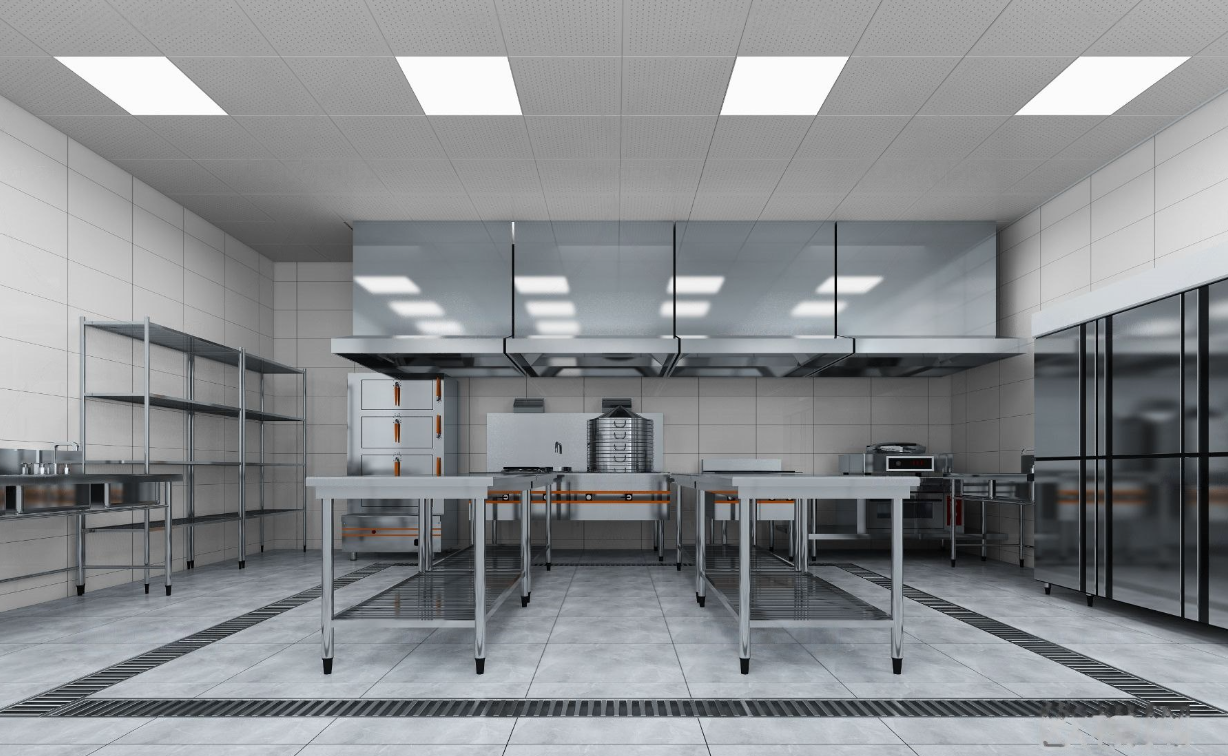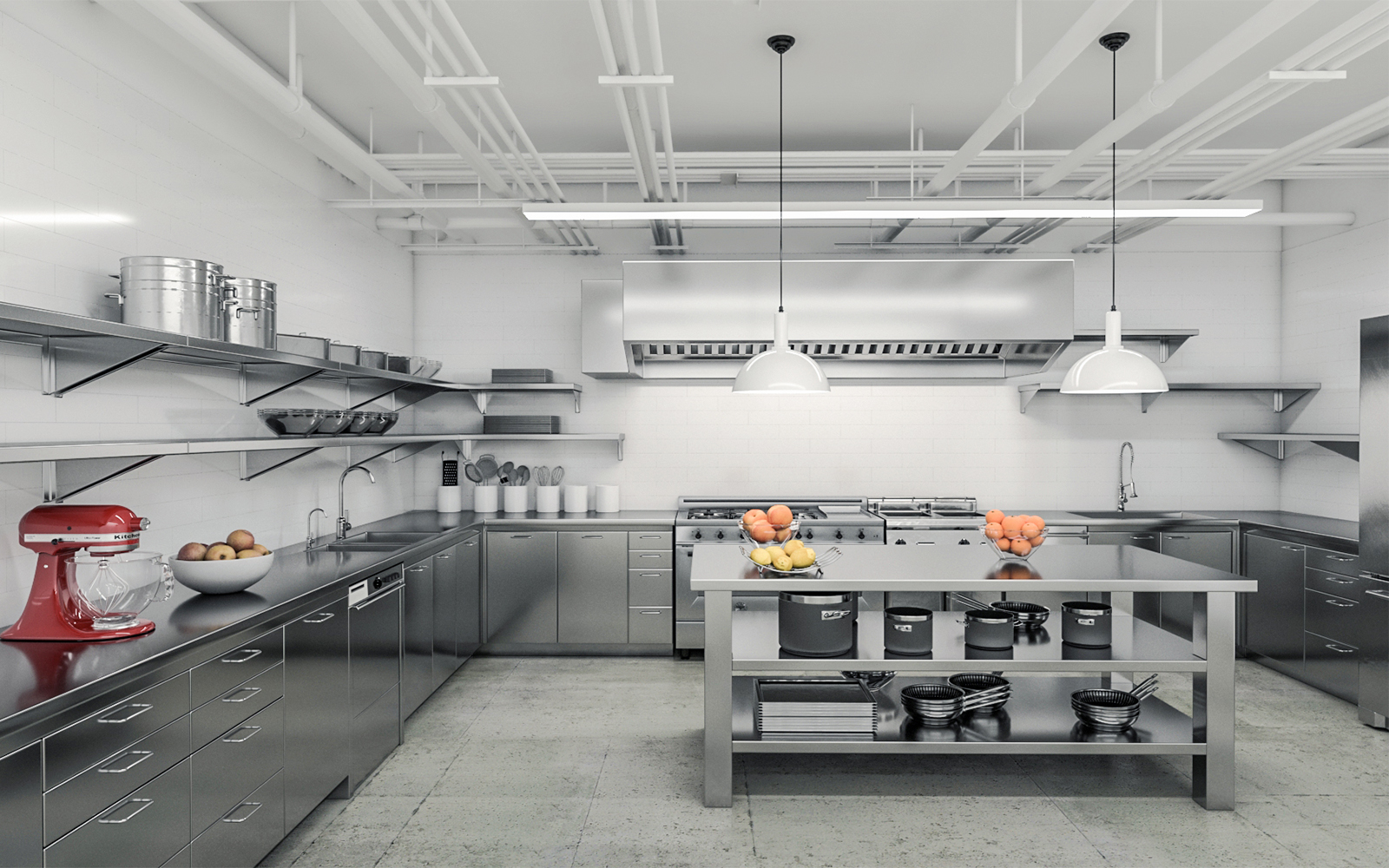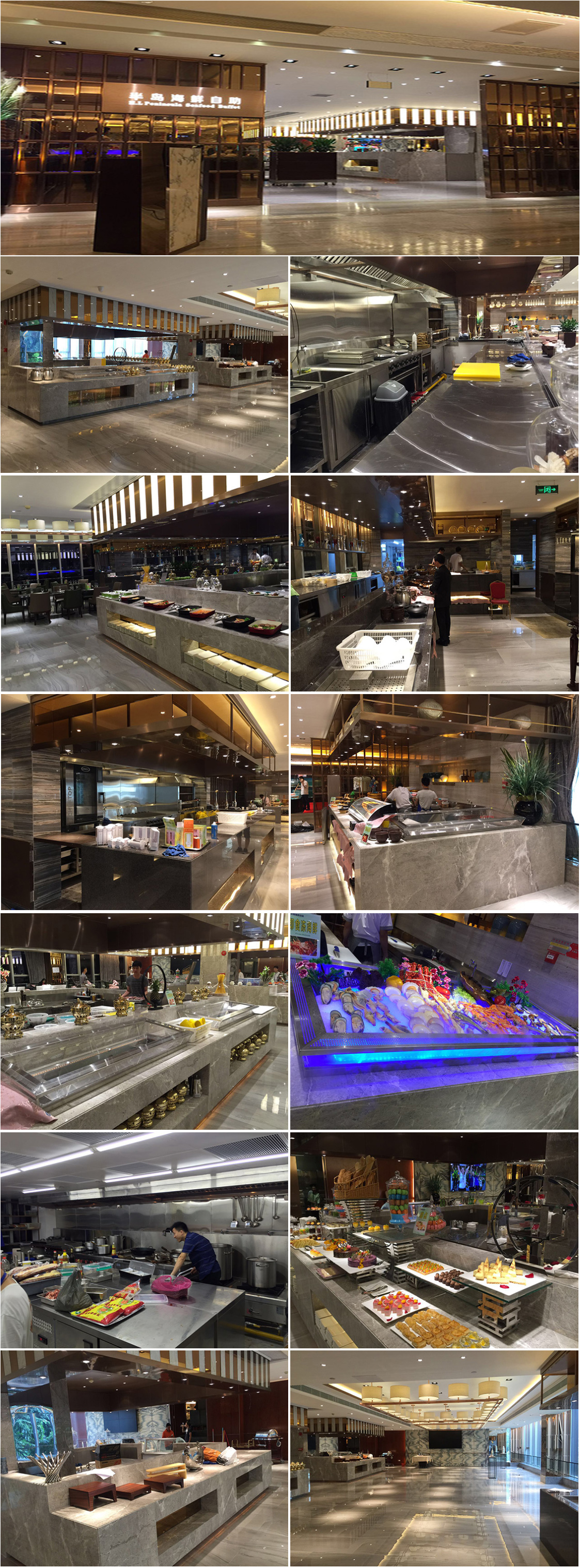How to design commercial kitchen projects for best results
Designing commercial kitchen projects to achieve the best results requires comprehensive consideration of a number of aspects, including layout planning, functional partitioning, equipment selection, safety, hygiene, efficiency, aesthetics and economy. Here are some key steps and considerations for commercial kitchen engineering design summarised by Guangzhou Acooker Kitchen Equipment Co.,Ltd :
1.Pre-planning and research
1.1 Clear demand: first of all, you need to clarify the specific needs and objectives of the commercial kitchen, including the use of the kitchen (such as restaurants, hotels, school canteens, etc.), the type of dishes, the daily flow of customers, the size of the chef team, and so on.
1.2 Space assessment: a detailed assessment of the existing kitchen space, including size, shape, structure, etc., in order to develop a reasonable layout plan.
1.3 Market research: to understand the mainstream kitchen equipment and materials on the market, as well as their performance, price, service life and other information, to provide a basis for equipment selection.How to design commercial kitchen projects for restaurant and hotel

2.Second, layout planning
2.1 Process optimisation: according to the characteristics of the kitchen work, rational planning of the workflow, to ensure smooth and unimpeded from the receipt of food materials, storage, processing, cooking to the various aspects of the meal. This helps to reduce the repetition and detour of personnel and logistics, improve efficiency.
2.2 Functional partition: according to the specific work of the kitchen, functional partition. Common zoning includes cooking area, dining area, storage area, cleaning area and so on. Each area has its own specific work content and requirements, the need for reasonable allocation of space and resources.
2.3 Line design: design a reasonable line, so that staff moving in the kitchen can quickly and easily reach the various work areas. The line design should follow the principle of ‘shortest path’ to reduce unnecessary walking distance and time.
3. Equipment selection and layout
3.1 Equipment selection: according to the needs of the kitchen and budget, choose stable performance, simple operation, easy maintenance of the kitchen equipment. At the same time, consider the energy efficiency ratio and environmental performance of the equipment to reduce operating costs and environmental impact.
3.2 Equipment layout: according to the kitchen layout planning and line design, reasonable arrangement of equipment placement. Appropriate distance should be maintained between the equipment so that the staff can operate and maintain. At the same time, it is necessary to ensure that the ventilation, heat dissipation and drainage requirements of the equipment are met.
4. Safety and hygiene
4.1 Safety: commercial kitchen design should ensure compliance with relevant national and local fire and building safety regulations. Set up a reasonable fire partition, configure automatic sprinkler system and gas alarm system and other safety measures. At the same time, to consider the equipment leakage prevention, high temperature and other safety features.
4.2 Hygiene: kitchen design should meet the health standards to ensure that the ingredients and tableware cleanliness and hygiene. Reasonably set up cleaning pool, disinfection cabinet and other sanitary facilities, and plan the storage and removal route of rubbish. In addition, the kitchen should maintain good ventilation and lighting conditions to reduce bacterial growth and odour generation.How to design commercial kitchen projects for restaurant and hotel
5. Aesthetics and economy
5.1 Aesthetics: commercial kitchen design should not only focus on practicality and functionality, but also consider aesthetics. Reasonable colour matching, clean working environment and humane design elements can enhance the overall atmosphere of the kitchen and staff motivation.
5.2 Economy: in the design process should focus on cost control and benefit analysis. Reasonable use of space resources, select cost-effective equipment and materials and the use of energy-saving design solutions can reduce the operating costs of the kitchen and improve economic efficiency.
In summary, the design of commercial kitchen projects need to consider a number of factors, and focus on detailing and innovative design. Only in this way can we create both practical and beautiful, both safe and economical commercial kitchen project!How to design commercial kitchen projects for restaurant and hotel

Creating a commercial kitchen involves detailed planning and consideration of various aspects. Here are some frequently asked questions (FAQ) related to commercial kitchen design:
1. What are the essential components of a commercial kitchen?
- Preparation Area: Space for chopping, mixing, and preparing ingredients.
- Cooking Area: Includes stoves, ovens, fryers, and grills.
- Storage Area: Refrigeration, freezers, and dry storage for ingredients.
- Cleaning Area: Sinks, dishwashers, and areas for waste disposal.
- Service Area: Where food is plated and sent out to customers.
2. What are the key factors to consider in designing a commercial kitchen?
- Workflow Efficiency: The layout should minimize unnecessary movement and ensure a smooth workflow.
- Space Utilization: Maximize space for equipment and staff while maintaining safety.
- Ventilation: Proper ventilation is crucial for removing heat, smoke, and odors.
- Compliance: Adherence to local health and safety codes.
- Accessibility: Ensure that all areas and equipment are accessible to staff.
3. What are the most common kitchen layouts for commercial kitchens?
- Island Layout: Centralized cooking area with surrounding prep and storage.
- Assembly Line Layout: Ideal for high-volume production, such as in cafeterias.
- Zone Layout: Each area is designated for specific tasks (prep, cooking, cleaning).
- Open Kitchen Layout: Allows customers to see the kitchen, common in trendy restaurants.
4. How can I ensure proper ventilation in a commercial kitchen?
- Use a high-quality hood and exhaust system to remove smoke and fumes.
- Ensure the kitchen layout facilitates air circulation.
- Install make-up air units to balance the exhaust and maintain air pressure.
5. What types of equipment are essential for a commercial kitchen?
- Cooking Equipment: Ovens, grills, fryers, and stoves.
- Preparation Equipment: Mixers, slicers, and food processors.
- Refrigeration Equipment: Walk-in refrigerators and freezers, reach-in coolers.
- Cleaning Equipment: Commercial dishwashers, sinks, and waste disposal systems.
6. How much space is required for a commercial kitchen?
- The size varies depending on the type of establishment. A general guideline is:
- Fast Food/Quick Service: 200-300 sq. ft.
- Full-Service Restaurant: 300-500 sq. ft.
- Catering or Banquet Facilities: 500-1000 sq. ft. or more.
7. How do I plan for safety and hygiene in a commercial kitchen?
- Ensure non-slip flooring and rounded edges on countertops.
- Place handwashing stations in accessible areas.
- Install proper storage systems to separate raw and cooked foods.
- Use stainless steel surfaces for easy cleaning and durability.
8. What are some common mistakes to avoid in commercial kitchen design?
- Overcrowding: Avoid placing too much equipment in a small space.
- Poor Workflow Planning: Inefficient layouts can lead to bottlenecks.
- Insufficient Ventilation: Can cause overheating and discomfort.
- Neglecting Compliance: Failing to meet local health and safety standards can lead to fines and closures.
9. How do I choose the right materials for a commercial kitchen?
- Stainless Steel: Durable, easy to clean, and resistant to heat and corrosion.
- Ceramic Tiles: Good for flooring as they are easy to clean and resistant to spills.
- Tempered Glass: Used for shelving or partitions for aesthetic appeal and durability.
10. How can technology be integrated into a commercial kitchen?
- Smart Appliances: Ovens, refrigerators, and dishwashers with remote monitoring and automation.
- Inventory Management Systems: To track ingredient levels and reduce waste.
- Kitchen Display Systems (KDS): Digital screens for order management and communication.

Key points to consider for commercial kithen design project:
1. Project Goals and Objectives
- Clearly define what you want to achieve with the kitchen design (e.g., increase efficiency, expand menu options).
2. Budget Planning
- Establish a budget early on and include costs for equipment, construction, permits, and ongoing maintenance.
3. Space Planning and Layout
- Design an efficient layout that minimizes workflow disruptions.
- Consider zoning for cooking, preparation, and cleaning areas.
- Ensure there’s enough space for staff movement and equipment access.
4. Equipment Selection
- Choose equipment that fits your menu needs and volume requirements.
- Invest in energy-efficient appliances to reduce operational costs.
5. Compliance with Regulations
- Familiarize yourself with local health codes, safety regulations, and fire codes.
- Ensure the design allows for compliance with sanitation and safety standards.
6. Ventilation and Air Quality
- Design an effective ventilation system to manage heat, smoke, and odors.
- Consider the location of windows and doors for natural ventilation.
7. Plumbing and Electrical Considerations
- Plan for adequate plumbing for sinks, dishwashers, and cooking equipment.
- Ensure the electrical system can support the kitchen’s power needs.
8. Workflow Efficiency
- Design the kitchen to follow the natural flow of food preparation, cooking, and service.
- Consider using a triangle layout to optimize movement between stations.
9. Storage Solutions
- Include sufficient refrigeration, dry storage, and shelving.
- Design for easy access and organization to streamline operations.
10. Staff Training and Safety
- Plan for staff training on equipment use and safety procedures.
- Ensure the design incorporates safety features, like non-slip flooring and emergency exits.
11. Sustainability Practices
- Consider incorporating eco-friendly materials and energy-efficient systems.
- Explore waste management solutions, such as composting and recycling areas.
12. Timeline Management
- Set realistic timelines for each phase of the project, from design to construction and equipment installation.
- Keep stakeholders informed of progress and any changes.
13. Future Expansion
- Design with flexibility in mind to accommodate future growth or changes in the menu.
14. Regular Reviews and Adjustments
- Continuously review the design against operational needs and make adjustments as necessary.
- Gather feedback from staff after implementation to identify areas for improvement.

About us
Welcome to Guangzhou Acooker Kitchen Equipment Co.,Ltd, where culinary dreams come to life. As a leading one-stop solution commercial kitchen project company, we take pride in providing end-to-end solutions for restaurants, hotels, resorts,bakeries, fast-food establishments, coffee shops,buffet restaurants and more. Our commitment to excellence, innovation, and customer satisfaction sets us apart as the go-to partner for businesses looking to create or upgrade their culinary spaces.
Our Comprehensive Approach:
At Guangzhou Acooker Kitchen Equipment Co.,Ltd , we understand the intricate needs of diverse culinary establishments. Our mission is to simplify the process of setting up or renovating your kitchen by offering a comprehensive range of high-quality equipment tailored to your specific requirements. Whether you’re envisioning a modern restaurant, a cozy coffee shop, or a bustling bakery, we have the expertise and products to turn your vision into reality.How to design commercial kitchen projects for restaurant and hotel
Explore our diverse and extensive product portfolio, carefully curated to cover every aspect of your commercial kitchen project:
Cooking Equipment: Unleash the full potential of your kitchen with our state-of-the-art cooking appliances, including ranges, ovens, grills, fryers, and more.
Refrigeration Equipment: Keep your ingredients fresh and your operations streamlined with our efficient refrigeration systems, ranging from walk-in coolers to display cases.
Bakery Equipment: Elevate your baking game with our specialized bakery equipment, including dough mixers, ovens, proofers, and everything you need for a successful bakery.
Fast Food Solutions: Optimize your fast-food operations with our high-performance equipment designed for speed, efficiency, and quality.
Coffee Shop Essentials: Create a cozy and inviting coffee shop atmosphere with our coffee machines, grinders, and other essentials for the perfect brew.
Why Choose Guangzhou Acooker Kitchen Equipment Co.,Ltd :
End-to-End Solutions: We provide a seamless and integrated approach to commercial kitchen projects, from conceptualization to installation, ensuring a hassle-free experience.
Quality Assurance: Our products undergo rigorous testing to meet and exceed industry standards, ensuring durability, reliability, and optimal performance.
Customer-Centric Focus: Your satisfaction is our priority. Our team is dedicated to providing personalized support, expert advice, and timely maintenance services to keep your kitchen running smoothly.How to design commercial kitchen projects for restaurant and hotel
Innovation: Stay ahead of the curve with our innovative solutions, designed to enhance efficiency, reduce energy consumption, and meet the evolving demands of the culinary industry.
Connect with Us:
Discover how Guangzhou Acooker Kitchen Equipment Co.,Ltd can be the catalyst for your culinary success. For inquiries, consultations, or to explore our comprehensive product range, contact us at andy@acooker.com.
At Guangzhou Acooker Kitchen Equipment Co.,Ltd , we don’t just provide equipment; we deliver a complete solution that ensures your commercial kitchen is equipped for success in every culinary endeavor.
Successful project:

Product Video:  Follow us on Facebook
Follow us on Facebook 
Product Category
| >Cooking Equipment | >Refrigeration Equipment | >Bakery Equipment | >Food Processing Equipment | >S.S. Furniture
| >Food Display Equipment | >Snack equipment | > | >Furniture | >Small Wares

